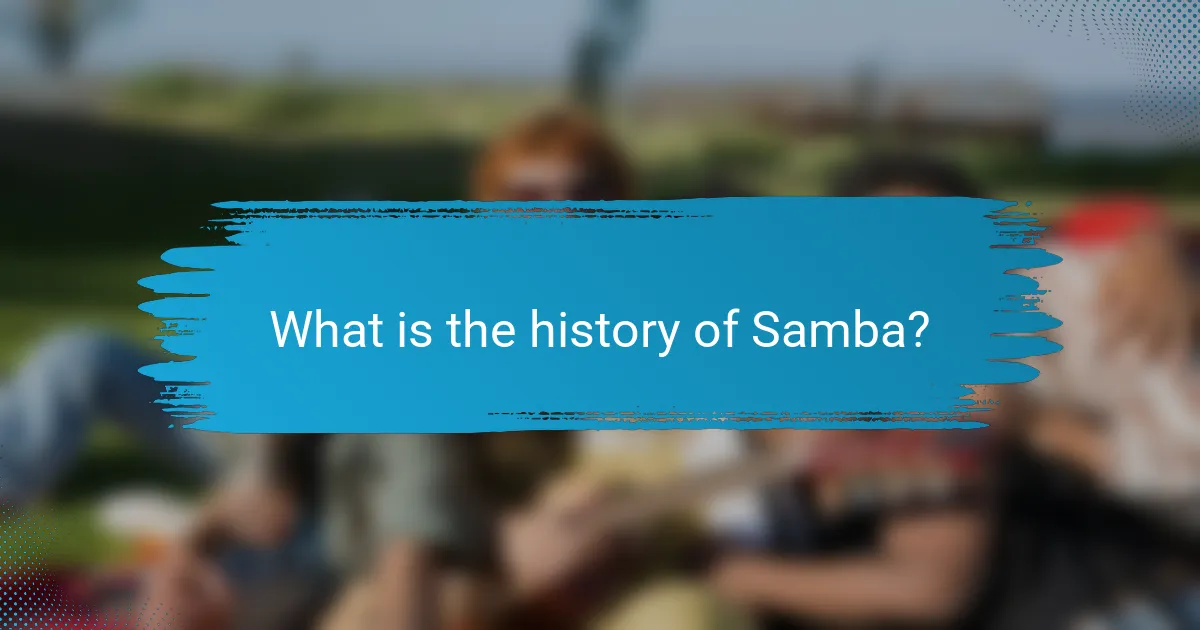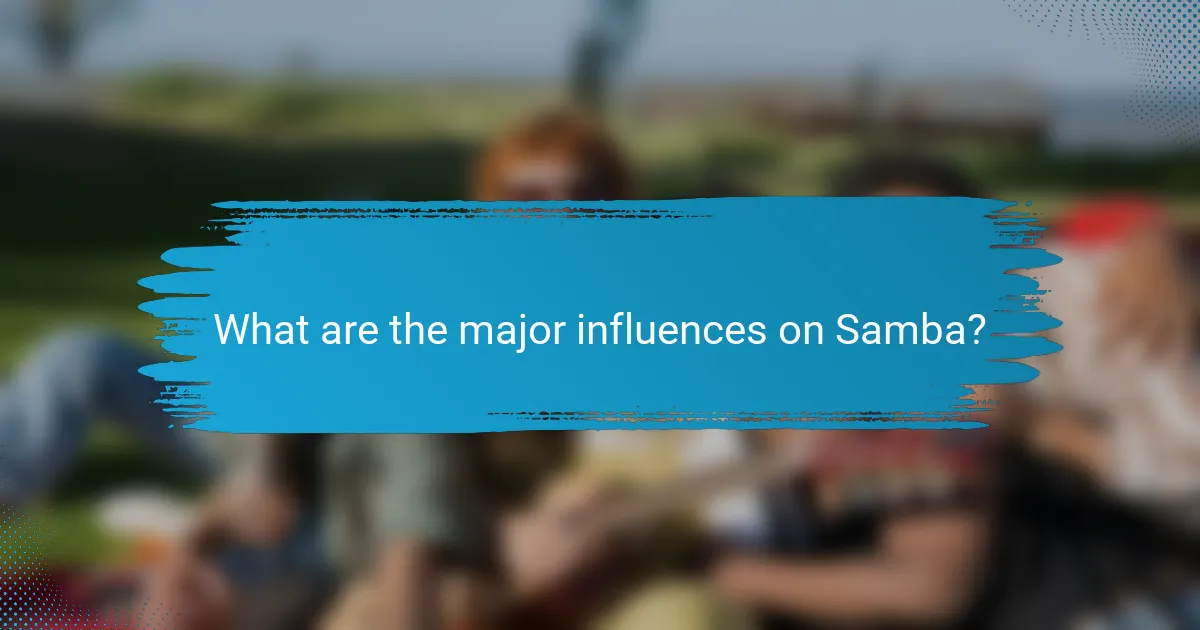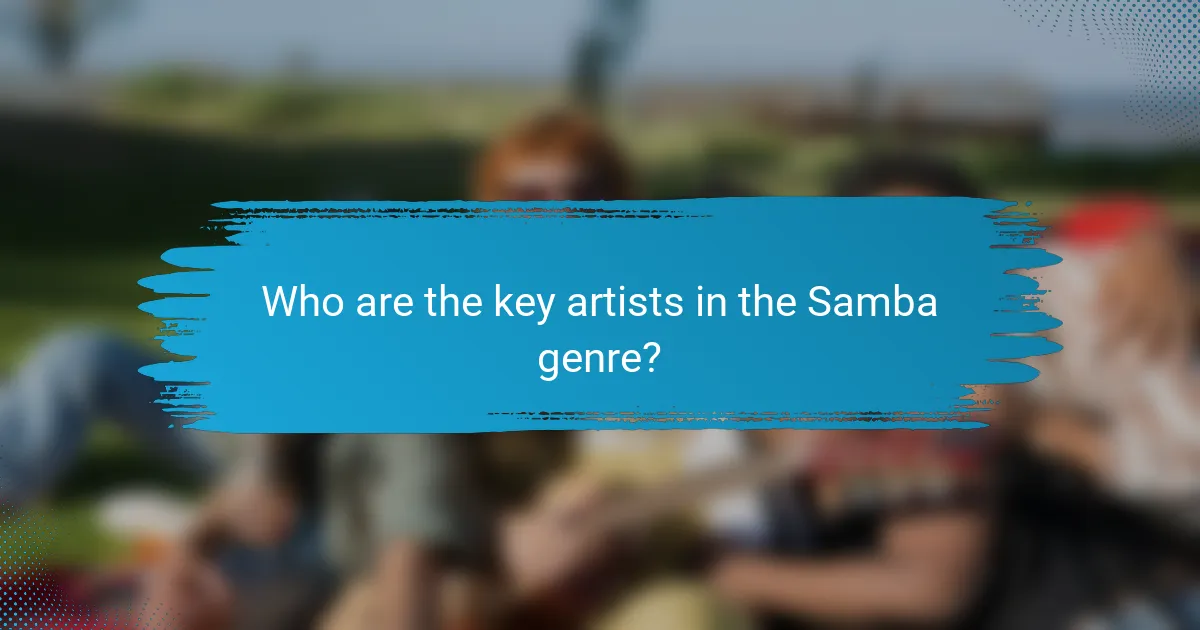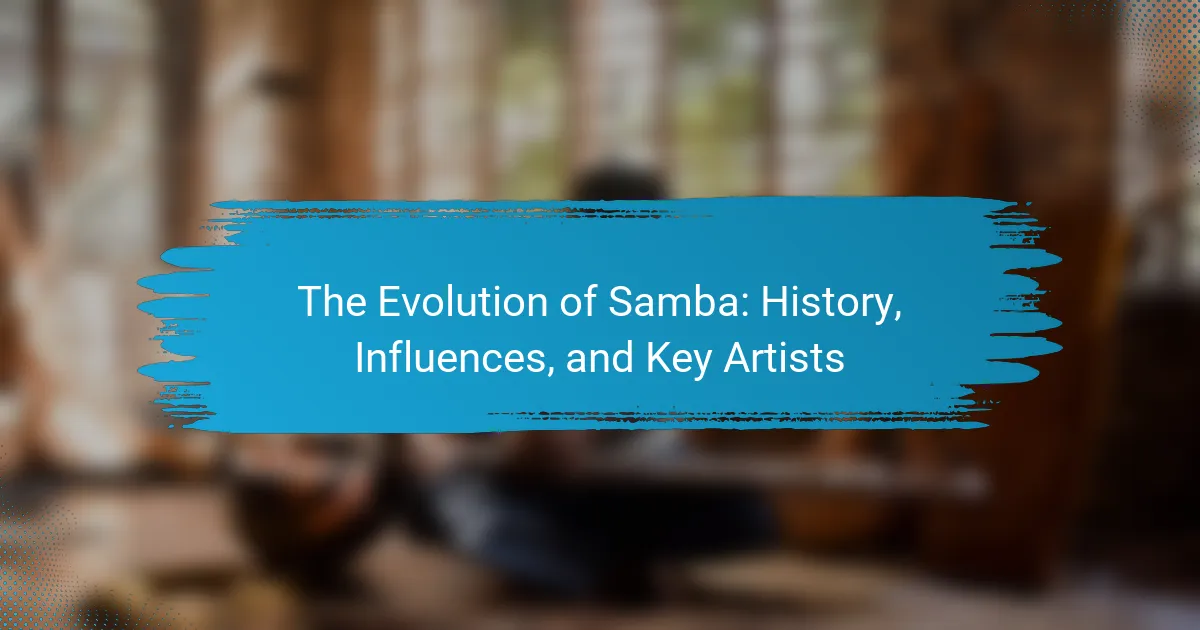Samba is a Brazilian music genre that originated in the early 20th century, evolving from African rhythms brought by enslaved people. It gained popularity during the 1920s, particularly during Carnaval, and reflects a blend of African, Portuguese, and indigenous Brazilian cultures. The genre was significantly shaped by various musical styles, including maxixe and choro, and the founding of the first samba school, Deixa Falar, in 1928 marked a pivotal moment in its history. Key artists such as Cartola, Noel Rosa, and Gilberto Gil have played essential roles in defining and popularizing Samba, contributing to its status as a symbol of Brazilian identity and cultural expression. The article explores the history, influences, and notable figures that have shaped Samba into a unique and globally recognized genre.

What is the history of Samba?
Samba originated in Brazil in the early 20th century. It evolved from African rhythms brought by enslaved people. The genre became popular in the 1920s during the Carnaval celebrations. Samba was influenced by various musical styles, including maxixe and choro. It reflects a blend of African, Portuguese, and indigenous Brazilian cultures. The first samba school, Deixa Falar, was founded in 1928 in Rio de Janeiro. By the 1930s, samba gained national recognition through radio broadcasts and recordings. Today, samba is a symbol of Brazilian identity and cultural expression.
How did Samba originate in Brazil?
Samba originated in Brazil as a fusion of African rhythms and Portuguese musical elements. It developed in the early 20th century, particularly in the Afro-Brazilian communities of Rio de Janeiro. The genre was influenced by African dance forms brought by enslaved people. These rhythms blended with local Brazilian music styles. Samba became popular during the Carnival celebrations in Brazil. The first samba schools were established in the 1920s, formalizing the genre. By the 1930s, samba gained national prominence through radio and recordings. Today, samba is a symbol of Brazilian culture and identity.
What cultural influences contributed to the development of Samba?
Samba developed through a blend of African, Indigenous, and European cultural influences. African rhythms and dance forms significantly shaped its musical structure. The enslaved Africans brought to Brazil infused their traditions into the music. Indigenous Brazilian elements also contributed unique instruments and melodies. European music, particularly Portuguese folk songs, influenced samba’s lyrical style. The combination of these diverse influences created a distinct genre. The first recorded samba dates back to the early 20th century in Rio de Janeiro. This evolution reflects Brazil’s multicultural heritage and social dynamics.
How did the African diaspora shape Samba’s early forms?
The African diaspora significantly influenced the early forms of Samba. African slaves brought to Brazil contributed rhythms and musical styles. They integrated traditional African instruments like the berimbau and atabaque. These elements formed the foundation of Samba’s sound. The blending of African cultural practices with local Brazilian traditions shaped its development. Community gatherings and celebrations fostered the evolution of Samba. This cultural exchange created a unique musical genre. Historical records indicate that Samba emerged in the early 20th century, reflecting these diverse influences.
What are the key historical milestones in Samba’s evolution?
Samba’s evolution includes several key historical milestones. In the late 19th century, samba emerged from Afro-Brazilian communities in Rio de Janeiro. The genre gained popularity in the 1910s with the formation of samba schools. In 1929, the first samba recording was made, marking a significant milestone. The 1930s saw samba integrated into Brazilian carnival celebrations. By the 1940s, samba became a symbol of Brazilian national identity. The 1960s introduced bossa nova, blending samba with jazz influences. In the 1980s, samba experienced a resurgence through artists like Zeca Pagodinho. Today, samba continues to evolve, embracing various styles and influences.
How did Samba evolve through the 20th century?
Samba evolved significantly throughout the 20th century. Initially, it emerged from Afro-Brazilian communities in the early 1900s. The genre blended African rhythms with Brazilian musical styles. In the 1920s, samba gained popularity in urban areas, particularly in Rio de Janeiro. The first samba schools were established during this time, formalizing the genre’s structure. By the 1930s, samba became a symbol of Brazilian identity. It was embraced by the mainstream music scene and featured in films and radio broadcasts. The 1940s and 1950s saw the rise of notable samba artists like Cartola and Noel Rosa. In the 1960s, bossa nova emerged, incorporating samba elements with jazz influences. The genre continued to evolve, integrating various musical styles and social themes. By the end of the century, samba was recognized globally, influencing numerous artists worldwide.
What role did political changes play in the development of Samba?
Political changes significantly influenced the development of Samba. The abolition of slavery in Brazil in 1888 allowed formerly enslaved people to participate in cultural expressions. This led to the emergence of Samba as a vital form of cultural identity among Afro-Brazilians. The political climate of the early 20th century saw the rise of nationalism, which embraced Samba as a symbol of Brazilian culture. The government promoted Samba during the 1930s and 1940s as part of national identity, especially during Carnaval. Political support helped legitimize Samba, elevating it from marginalized origins to mainstream acceptance. The military dictatorship from 1964 to 1985 also impacted Samba, leading to censorship but simultaneously fostering creativity and resistance through the genre. Overall, political changes shaped Samba’s evolution, reflecting broader societal transformations in Brazil.

What are the major influences on Samba?
Samba is primarily influenced by African rhythms, Brazilian folk music, and European musical styles. African influences stem from enslaved Africans who brought their musical traditions to Brazil. These traditions include complex rhythms and call-and-response patterns. Brazilian folk music contributed local melodies and dance forms, enriching Samba’s cultural tapestry. European styles, particularly from Portuguese music, introduced harmonies and instruments like the guitar. The fusion of these diverse influences shaped Samba into a unique genre. Notably, the early 20th century saw Samba evolve in urban centers like Rio de Janeiro, reflecting social changes and cultural exchanges.
How did other music genres influence Samba?
Other music genres significantly influenced Samba. African rhythms and melodies form the foundation of Samba’s sound. The incorporation of jazz introduced improvisation and complex harmonies. Bossa Nova added a softer, melodic style to traditional Samba. Cumbia and other Latin rhythms contributed to Samba’s diverse beats. The fusion with rock and pop has modernized Samba, attracting younger audiences. Historical migration patterns brought various musical influences into Brazil, enriching Samba’s evolution. This blend of genres has helped Samba remain relevant and dynamic over time.
What impact did Bossa Nova have on Samba?
Bossa Nova significantly influenced Samba by introducing new rhythms and harmonies. This genre emerged in the late 1950s in Brazil. It blended elements of Samba with jazz, creating a softer sound. The use of complex chords and syncopated rhythms became prominent. Bossa Nova artists like João Gilberto and Tom Jobim redefined traditional Samba. They emphasized a more intimate vocal style and sophisticated arrangements. This evolution helped popularize Samba globally. Bossa Nova’s impact led to the fusion of various musical styles within Brazilian music.
How did Jazz and Blues contribute to Samba’s sound?
Jazz and Blues significantly influenced Samba’s sound by introducing new rhythms and improvisational styles. The syncopated rhythms of Jazz blended with Samba’s traditional beats, creating a richer texture. Blues contributed its emotional depth and lyrical storytelling, enhancing Samba’s expressive quality. In the 1930s, Brazilian musicians began incorporating Jazz elements into their compositions. Notable artists like Ary Barroso and João Gilberto fused these genres, leading to the development of Bossa Nova. This fusion expanded Samba’s appeal beyond Brazil, influencing global music trends. The integration of Jazz and Blues solidified Samba’s identity as a dynamic and evolving genre.
What cultural elements are intertwined with Samba?
Samba is deeply intertwined with elements of African heritage, Brazilian culture, and social commentary. African rhythms and dances significantly influence Samba’s musical structure. The genre emerged in the early 20th century, reflecting the experiences of Afro-Brazilians. Samba’s lyrics often address themes of love, struggle, and celebration. The annual Carnival showcases Samba’s vibrant expression and communal spirit. Instruments like the surdo and tamborim are central to its sound. Samba schools play a crucial role in preserving and innovating the tradition. This cultural phenomenon fosters a sense of identity and pride among its practitioners.
How does Samba reflect Brazilian cultural identity?
Samba reflects Brazilian cultural identity through its roots in African rhythms and Brazilian folk traditions. This genre embodies the diverse cultural influences that shape Brazil, including Indigenous, African, and European elements. The dance and music of Samba are integral to Brazilian festivals, especially Carnival, showcasing national pride and unity. Samba’s improvisational style allows for personal expression, reflecting the vibrant spirit of Brazilian communities. Historically, Samba emerged in the early 20th century in Rio de Janeiro’s favelas, symbolizing resilience and cultural heritage. Its evolution has been influenced by social and political movements, further embedding it in the national consciousness. Today, Samba continues to be a powerful symbol of Brazil’s multicultural identity and social dynamics.
What role do dance and festivals play in Samba’s cultural significance?
Dance and festivals are central to Samba’s cultural significance. They serve as expressions of community, identity, and heritage. Samba dance embodies the rhythm and spirit of Brazilian culture. Festivals, particularly Carnival, showcase Samba on a grand scale. During these events, participants celebrate their history and traditions. The vibrant performances attract global attention, promoting cultural exchange. Samba’s dance movements reflect African influences, highlighting its roots. Together, dance and festivals reinforce Samba’s status as a vital cultural symbol in Brazil.

Who are the key artists in the Samba genre?
Key artists in the Samba genre include Cartola, Noel Rosa, and Gilberto Gil. Cartola is renowned for his profound lyrics and melodies. He played a pivotal role in defining Samba’s lyrical depth. Noel Rosa contributed significantly with his innovative compositions and social commentary. His work addressed the struggles of the Brazilian people. Gilberto Gil is known for blending Samba with other genres, enhancing its global appeal. His contributions helped popularize Samba internationally. Other notable artists include Clara Nunes and Jorge Ben Jor, who further enriched the genre. Their unique styles and interpretations have left a lasting impact on Samba’s evolution.
What contributions have notable Samba artists made?
Notable Samba artists have significantly shaped the genre through innovative music and cultural influence. Artists like Cartola and Noel Rosa introduced complex lyrical themes and melodies. Their work helped elevate Samba from a local style to a national symbol of Brazil. Gilberto Gil and Caetano Veloso integrated Samba with other genres, expanding its reach. They played key roles in the Tropicália movement, blending traditional sounds with contemporary music. This fusion attracted global attention to Samba. Additionally, artists such as Clara Nunes and Jorge Ben Jor popularized Samba internationally. Their contributions have led to numerous awards and recognitions, solidifying Samba’s place in world music.
Who are the pioneers of Samba music?
The pioneers of Samba music include figures such as Donga, who is credited with composing the first recorded samba, “Pelo Telefone,” in 1917. Other key pioneers are Pixinguinha, a significant composer and musician, and Noel Rosa, known for his poetic lyrics and melodies. These artists played essential roles in shaping the genre during its early years. Their contributions laid the foundation for Samba’s development and popularity in Brazil. Donga’s work, in particular, marked a turning point in Brazilian music history.
How have contemporary artists shaped the modern Samba scene?
Contemporary artists have significantly influenced the modern Samba scene by introducing innovative styles and themes. They have blended traditional Samba with genres like hip-hop, funk, and electronic music. This fusion has broadened the appeal of Samba to younger audiences. Artists such as Anitta and Seu Jorge have gained international recognition, showcasing Samba on global platforms. Their collaborations with international musicians have further elevated the genre’s profile. Additionally, contemporary artists often address social issues through their music, reflecting the realities of modern Brazilian life. This has added depth and relevance to Samba, making it a vehicle for cultural expression and activism. The incorporation of new technologies in music production has also transformed how Samba is created and consumed. Overall, contemporary artists have revitalized Samba, ensuring its evolution while respecting its roots.
What are the defining characteristics of notable Samba musicians?
Notable Samba musicians are characterized by their rhythmic proficiency and cultural authenticity. They often possess a deep understanding of Brazilian music traditions. Many have a strong connection to Afro-Brazilian heritage, which influences their style. Their performances typically showcase vibrant energy and improvisation skills. Notable musicians often write original compositions that reflect social and political themes. They frequently collaborate with other artists, blending various musical styles. Renowned Samba musicians also engage with their communities, promoting cultural heritage. Their influence extends beyond music, impacting dance and fashion within the Samba culture.
How do the styles of different artists vary within Samba?
Different artists within Samba exhibit distinct styles influenced by their backgrounds and musical preferences. For instance, traditional Samba emphasizes rhythmic patterns and instrumentation, often featuring samba de roda. In contrast, artists like Jorge Ben Jor blend Samba with elements of bossa nova and rock, creating a fusion style. Another variation is found in the work of samba schools, which focus on elaborate performances during Carnival, showcasing choreography and themed narratives. Additionally, modern artists incorporate electronic elements, reflecting contemporary trends. These stylistic differences highlight the diversity within Samba, shaped by cultural influences and individual creativity.
What themes are commonly explored in the lyrics of Samba songs?
Themes commonly explored in the lyrics of Samba songs include love, celebration, and social issues. Love is often depicted through romantic relationships and emotional connections. Celebration is reflected in the joy of life, festivals, and community gatherings. Social issues are addressed through commentary on poverty, inequality, and cultural identity. Samba lyrics frequently emphasize resilience and hope amidst challenges. These themes resonate with the Brazilian experience and culture, making Samba a powerful form of expression. The historical context of Samba, rooted in Afro-Brazilian traditions, further enriches these themes.
What are some practical tips for exploring Samba music today?
Listen to classic Samba artists like João Gilberto and Gilberto Gil. Explore their albums to understand foundational styles. Attend local Samba events or workshops to experience the music live. Participating in dance classes can deepen your appreciation. Utilize streaming platforms to discover contemporary Samba artists. Follow playlists dedicated to Samba to stay updated. Read books about Samba’s history for context. Engage with online communities to discuss and share insights.
The main entity of this article is Samba, a Brazilian music genre that originated in the early 20th century. The article provides a comprehensive overview of Samba’s history, tracing its roots from African rhythms and cultural influences to its development and popularization during the 1920s Carnaval celebrations. Key historical milestones, the impact of political changes, and the evolution of Samba through various music genres, including Bossa Nova and Jazz, are discussed. Additionally, the article highlights notable artists who have shaped Samba’s identity and explores common themes in its lyrics, offering practical tips for engaging with Samba music today.
